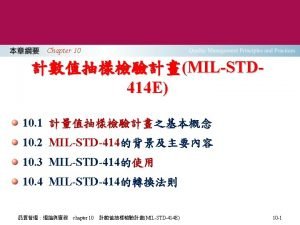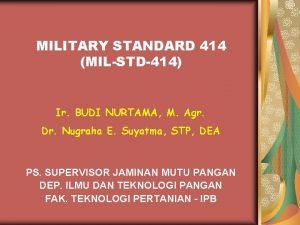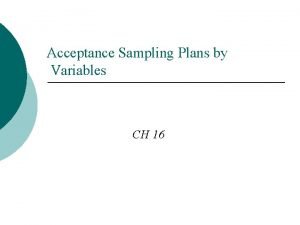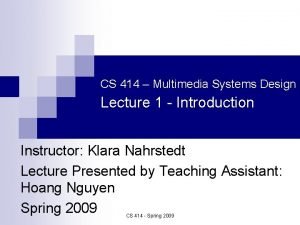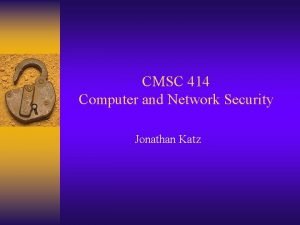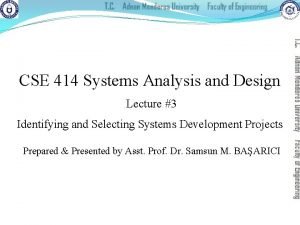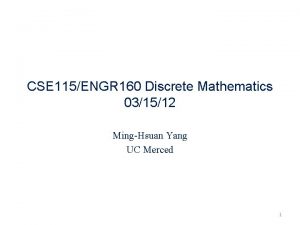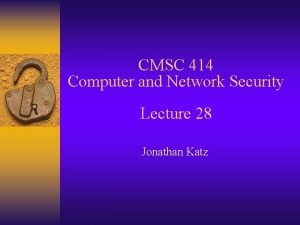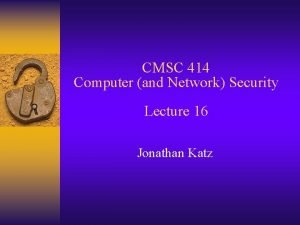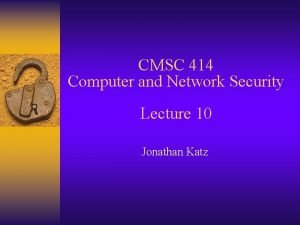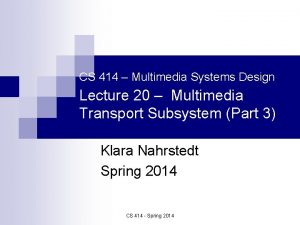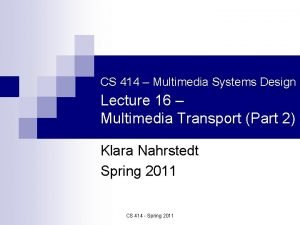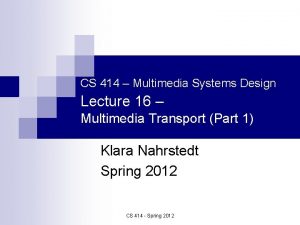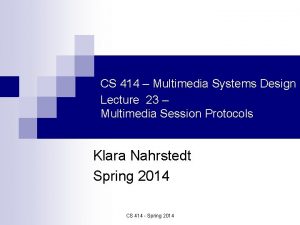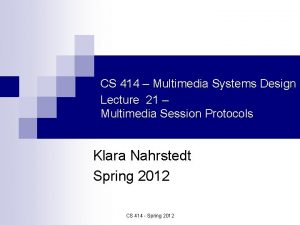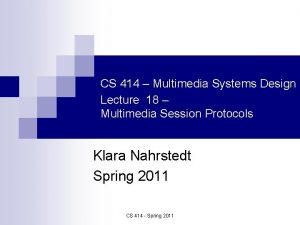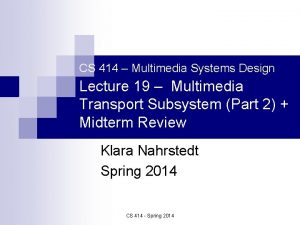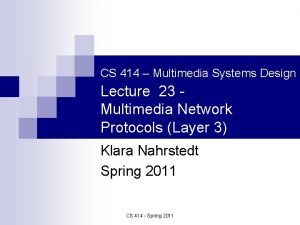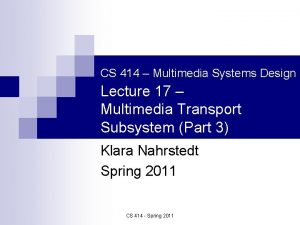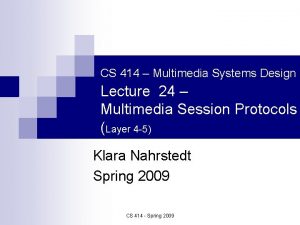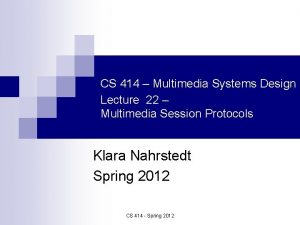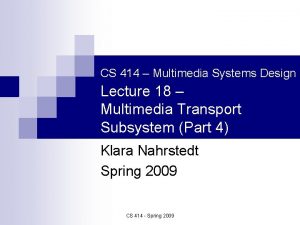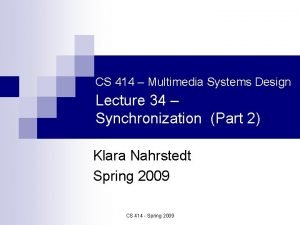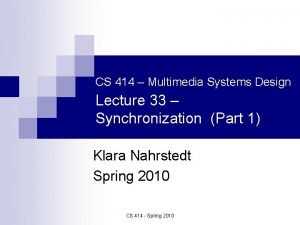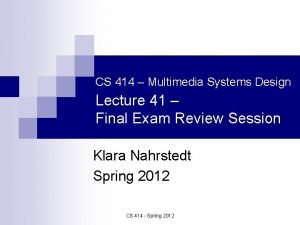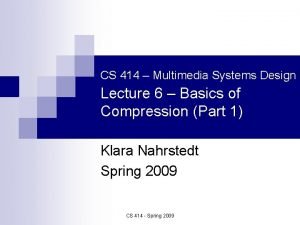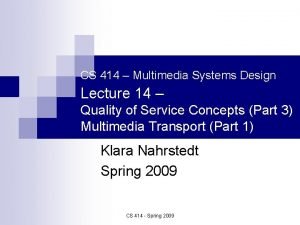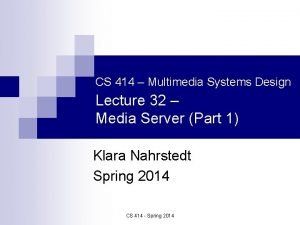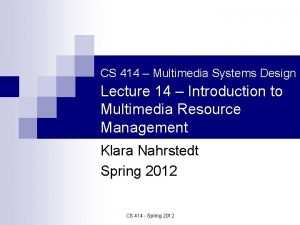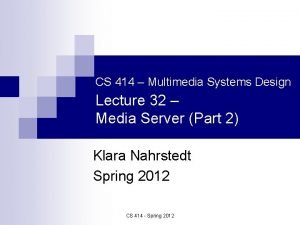CS 414 Multimedia Systems Design Lecture 22 Multimedia

























- Slides: 25

CS 414 – Multimedia Systems Design Lecture 22 - Multimedia Transport Protocols (Layer 3) Klara Nahrstedt Spring 2009 CS 414 - Spring 2009

Administrative n n Homework 1 ¨ average: 58. 2, std: 34. 86, median: 70. 5, max: 100; min: 0 Midterm ¨ average: 67. 7, std: 23. 68, median: 69. 5, max: 95, min: 0 Ramses Office Hours for midterm and HW 1 regrading: ¨ Thursday: 2: 30 pm - 3: 30 pm ¨ Friday: 3: 00 pm - 4: 00 pm ¨ room: 0207 SC Klara Office Hours for HW 1 regrading: ¨ Wednesday 9 -11 am, room 3104 SC CS 414 - Spring 2009

Administrative n MP 3 will be out today, March 16, 2009 ¨ Monday, Deadline, April 6 CS 414 - Spring 2009

Integrated Services (Int. Serv) Architecture Reservation Protocol (RSVP) End-system Router Control Plane Appl. RSVP daemon Policy control Routing. Admission control Packet classification RSVP daemon Policy control Admission control Packet scheduler Error Handling Data Plane CS 414 - Spring 2009 Packet scheduler

Guaranteed Service (in Int. Serv) n n n Provides guaranteed BW and strict bounds on end-toend queuing delay for conforming flows Controls max. queuing delay TSpec – describes traffic sources ¨ ¨ ¨ Bucket rate (‘r’) (bytes/second) Peak rate (p) (bytes/second) Bucket depth (b) (bytes) Minimum policed unit (m) (bytes) – any packet with size smaller than m will be counted as m bytes Maximum packet size (M) (bytes) – max, packet size that can be accepted CS 414 - Spring 2009

Guaranteed Service (2) n Rspec ¨ Service rate (R) (bytes/second) – service rate or BW requirement ¨ Slack term (S) (µsec) – extra amount of delay that a node may add that still meets the EED (end-to-end delay) requirement. n n n This service does policing and shaping Resources are reserved at worst case For bursty traffic sources – low network utilization CS 414 - Spring 2009

Controlled Load Service (in Int. Serv) n No quantitative guarantees on delay bound or BW n This service model allows statistical multiplexing – statistical guarantees Very high % of transmitted packets will be successfully delivered ¨ Transit queuing delay experienced by a very high % of delivered packets will not greatly exceed min. delay ¨ n Invocation and Policing ¨ Specify TSpec (average values) and do admission, reservation, policing based on average TSpec CS 414 - Spring 2009

Int. Serv (Error Handling - Early Congestion Avoidance) Avr – Average Queue Length Max. Thres – Max Queue Length Threshold Min. Thres – Min. Queue Length Threshold IP packet IP packet Input Queue CS 414 - Spring 2009 Packet Scheduler

Int. Serv (Error Handling) Discard Algorithms n RED: Random Early Detection; ¨ single FIFO queue is maintained for all packets and packets are dropped randomly with a given probability when the average queue length exceeds minimum threshold (Min. Thresh). If max. threshold (Max. Thres) is exceeded, all packets are dropped n WRED – Weighted RED ¨ Drops packets selectively based on IP precedence CS 414 - Spring 2009

Incoming IP packet RED Compute Avr < Min. Thres Min < Avr < Max Avr > Max. Thres Calculate Packet drop probability Low probability High Drop packet Enqueue packet CS 414 - Spring 2009

Packet Scheduling (in Int. Serv) n Isolation versus Sharing ¨ Circuit-switched network (e. g. , telephone network) – n all flows are isolated, i. e. , each connection has dedicated resource ¨ Datagram-based Internet – all resources are shared on per-packet basis without any form of isolation and protection Int. Serv requires scheduling algorithms to support delay bounds Deterministic or statistical delay bounds ¨ Deterministic and statistical bounds reflect trade-offs between isolation and sharing ¨ CS 414 - Spring 2009

Packet Scheduling (in Int. Serv) n Simple Priority ¨ n Fair queuing approach ¨ n Allocate BW proportional to active flows based on their weights Deadline-based schemes ¨ n Be careful – a large volume of higher-priority packets can easily starve lower-priority packets Use EDF on packets Rate-based scheduling framework ¨ Has two components: regulator and scheduler ¨ Example: token bucket with fair queuing CS 414 - Spring 2009

Int. Serv/RSVP vs Diff. Serv Int. Serv/RSVP BB 13 BB Diff. Serv Internet 2 Qo. S: Overview and Experiences—Campus Focused Workshop on Advanced Networks (December 4, 2000)

Differentiated Services (Diff. Serv) n n Intended to address the following difficulties with Intserv and RSVP; Scalability: maintaining states by routers in high speed networks is difficult due to the very large number of flows Flexible Service Models: Intserv has only two classes, want to provide more qualitative service classes; want to provide ‘relative’ service distinction (Platinum, Gold, Silver, …) Simpler signaling: (than RSVP) many applications and users may only want to specify a more qualitative notion of service CS 414 - Spring 2009 (Acknowledgement: Original Source of Diff. Serv Slides is from CMU

Diffserv - Motivation n Do fine-grained enforcement only at the edge of the network. Typically slower links at edges ¨ E. g. , mail sorting in post office ¨ n Label packets with a field. ¨ n E. g. , a priority stamp The core of the network uses only the type field for Qo. S management. Small number of types with well defined forwarding behavior ¨ Can be handled fast ¨ n n Example: expedited service versus best effort Evolution rather than revolution CS 414 - Spring 2009

Diffserv - Discussion n Diffserv defines an architecture and a set of forwarding behaviors. It is up to the service providers to define and implement end-to-end services on top of this architecture. ¨ Offers a more flexible service model; different providers can offer different service. ¨ n One of the main motivations for Diffserv is scalability. ¨ n Keep the core of the network simple. Focus of Diffserv is on supporting Qo. S for flow aggregates. CS 414 - Spring 2009

Edge Router/Host Functions n n Classification: marks packets according to classification rules to be specified. Metering: checks whether the traffic falls within the negotiated profile. Marking: marks traffic that falls within profile. Conditioning: delays and then forwards, discards, or remarks other traffic. CS 414 - Spring 2009

Classification and Conditioning Packet is marked in the Type of Service (TOS) in IPv 4, and Traffic Class in IPv 6. n 6 bits used for Differentiated Service Code Point (DSCP) and determine PHB that the packet will receive. n 2 bits are currently unused. n CS 414 - Spring 2009

Core Functions Forwarding: according to “Per-Hop. Behavior” or PHB specified for the particular packet class; such PHB is strictly based on class marking (no other header fields can be used to influence PHB). n BIG ADVANTAGE: No state info to be maintained by routers! n CS 414 - Spring 2009

Forwarding (PHB) PHB result in a different observable (measurable) forwarding performance behavior. n PHB does not specify what mechanisms to use to ensure required PHB performance behavior. n Examples of PHB Behaviors: n ¨ Class A gets x% of outgoing link bandwidth over time intervals of a specified length. ¨ Class A packets leave first before packets from class CS 414 - Spring 2009 B.

Forwarding (PHB) n Expedited Forwarding (EF): ¨ Guarantees a certain minimum rate for the EF traffic. ¨ Implies isolation: guarantee for the EF traffic should not be influenced by the other traffic classes. ¨ Admitted based on peak rate. ¨ Non-conformant traffic is dropped or shaped. ¨ Possible service: providing a virtual wire. CS 414 - Spring 2009

Forwarding (PHB) n Assured Forwarding (AF): ¨ AF defines 4 classes with some bandwidth and buffers allocated to them. ¨ The intent is that it will be used to implement services that differ relative to each other (e. g. , gold, silver, …). ¨ Within each class, there are three drop priorities, which affect which packets will get dropped first if there is congestion. ¨ Lots of studies on how these classes and drop priorities interact with TCP flow control. ¨ Non-conformant traffic is remarked. CS 414 - Spring 2009

Example of EF: A Virtual Leased Line Service n Service offers users a dedicated traffic pipe. ¨ Guaranteed bandwidth between two points. ¨ Very low latency and jitter since there should be no queuing delay (peak rate allocation). n Admission control makes sure that all links in the network core have sufficient EF bandwidth. ¨ Simple case: sum of all virtual link bandwidth is less than the capacity of the slowest link. n Traffic enforcement for EF traffic limits how much EF traffic enters the network. CS 414 - Spring 2009

Differentiated Services Issues n The key to making Diffserv work is bandwidth management in the network core. Simple for simple services such as the virtual pipe, but it is much more challenging for complex service level agreements. ¨ Notion of a “bandwidth broker” that manages the core network bandwidth. ¨ n Definition of end-to-end services for paths that cross networks with different forwarding behaviors Some packets will be handled differently in different routers. ¨ Some routers are not Diff. Serv capable. ¨ CS 414 - Spring 2009

Conclusion n n Int. Serv and Diff. Serv are two major competing concepts, architectures and Qo. S management approaches for the multimedia traffic. Qbone Architecture – Inter-domain testbed for Diff. Serv in Internet 2 Cisco routers implement both, but usually system administrators at the edges do not enable them ISP may or may not use some of the concepts for traffic control. CS 414 - Spring 2009
 01:640:244 lecture notes - lecture 15: plat, idah, farad
01:640:244 lecture notes - lecture 15: plat, idah, farad Mil-std-414
Mil-std-414 Mil-std-414
Mil-std-414 Mil std 414
Mil std 414 414 climate change
414 climate change Cs 414
Cs 414 Cmsc414 umd
Cmsc414 umd Cse 414
Cse 414 Gcd of 414 and 662
Gcd of 414 and 662 Cmsc 414
Cmsc 414 Cmsc 414
Cmsc 414 Cmsc 414
Cmsc 414 Operating systems lecture notes
Operating systems lecture notes Lecture sound systems
Lecture sound systems Lecture sound systems
Lecture sound systems Multimedia becomes interactive multimedia when
Multimedia becomes interactive multimedia when Linear multimedia definition
Linear multimedia definition Csc 253
Csc 253 Esa multimedia.esa.int./multimedia/virtual-tour-iss
Esa multimedia.esa.int./multimedia/virtual-tour-iss Anchorage length eurocode
Anchorage length eurocode Urban design lecture
Urban design lecture Principles of design in interior design ppt
Principles of design in interior design ppt Lecture hall acoustic design
Lecture hall acoustic design Game design lecture
Game design lecture Computer-aided drug design lecture notes
Computer-aided drug design lecture notes Cmos vlsi design lecture notes
Cmos vlsi design lecture notes

